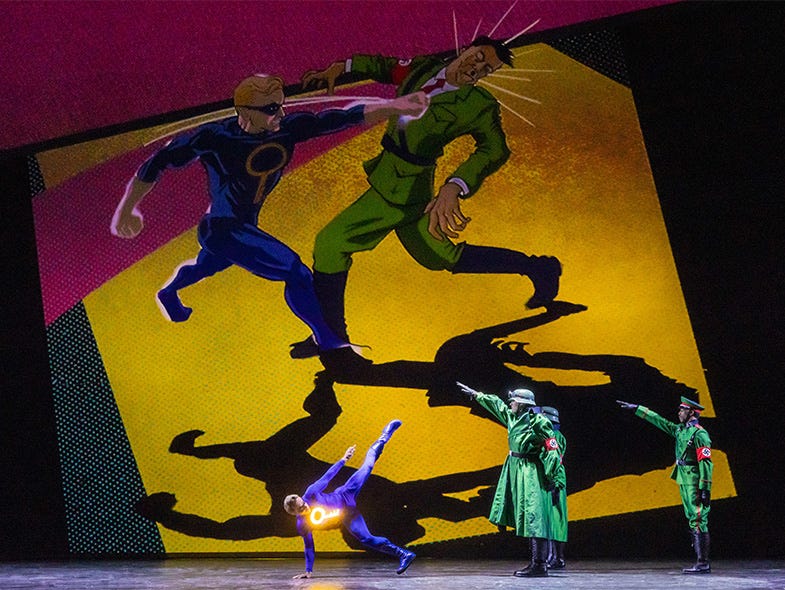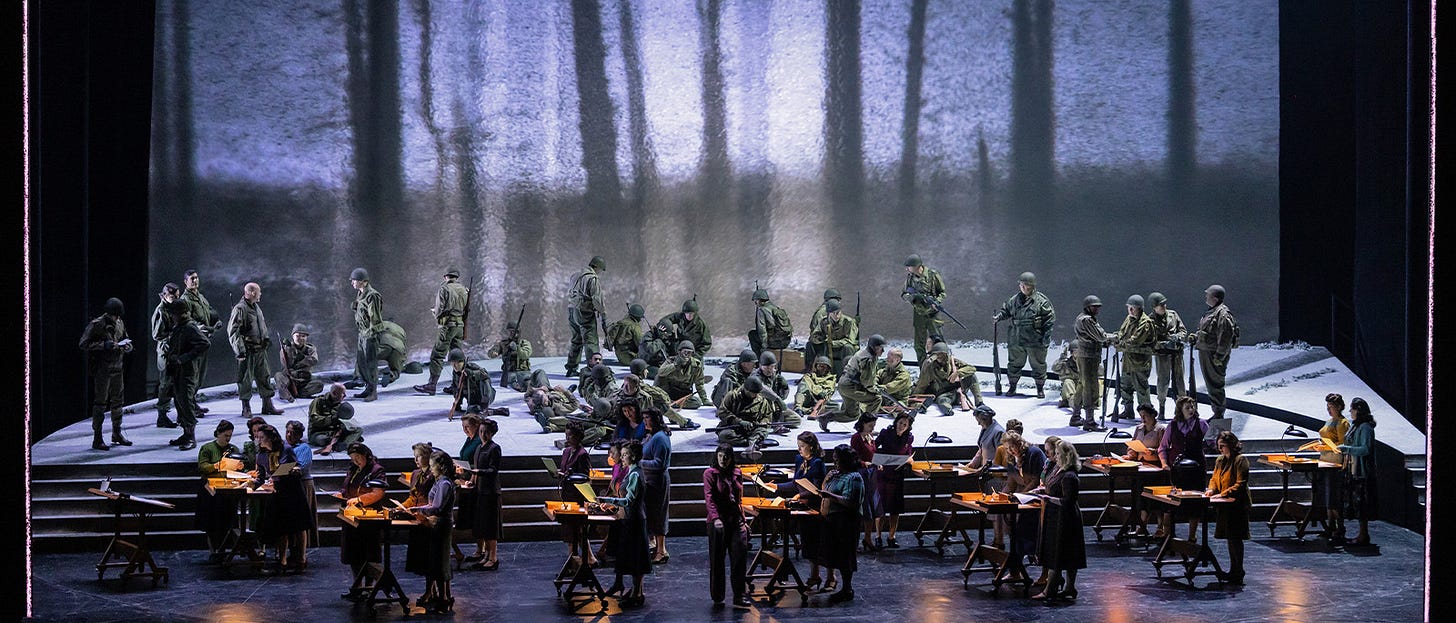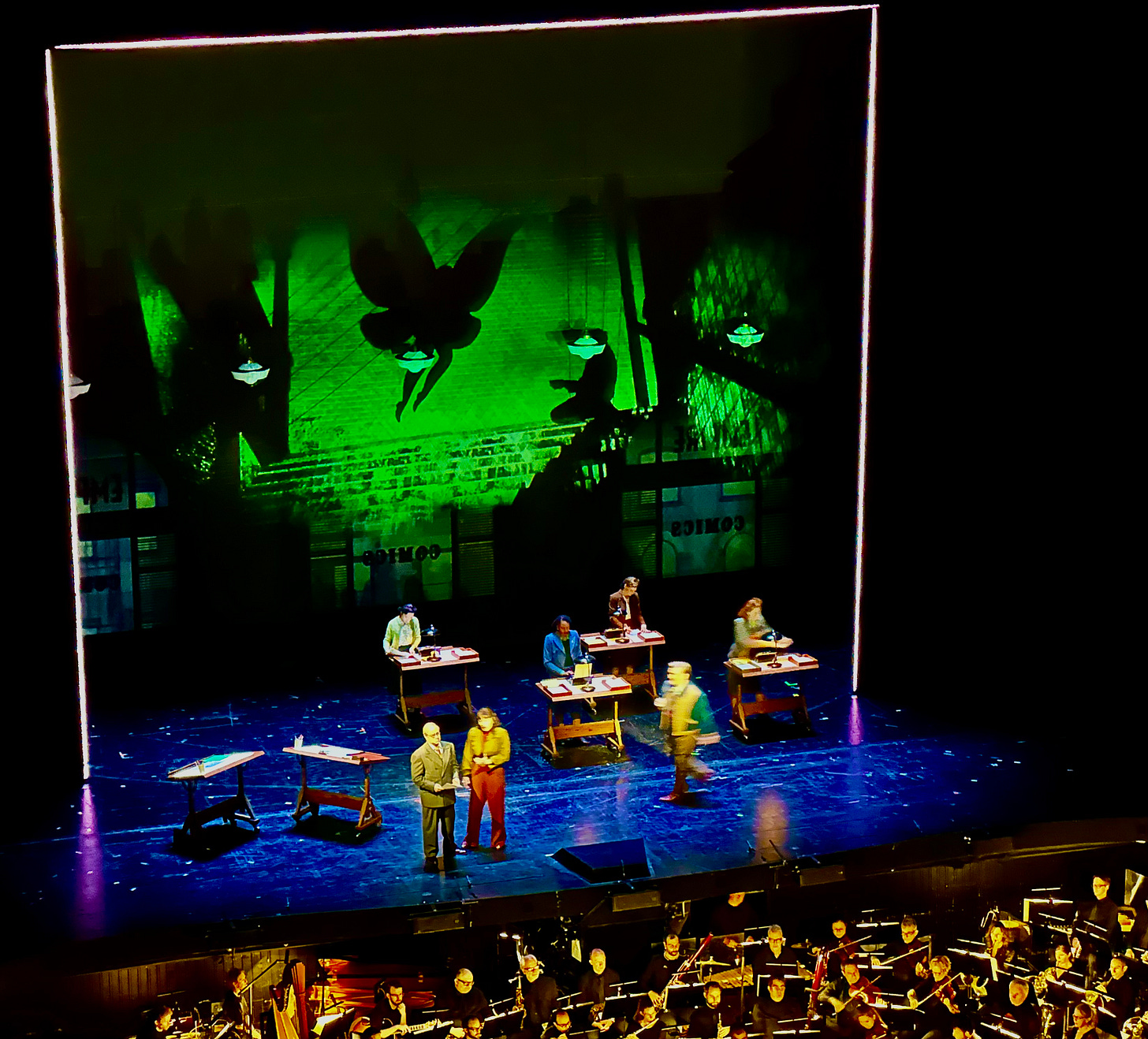Kavalier & Clay’s One Battle After Another
The Met's Comic Book Opera and PTA's Revolutionary Epic Chase the Same American Dream of Refuge
THE AMAZING ADVENTURES OF KAVALIER & CLAY
Metropolitan Opera House
September 26, 2025, 8:00 PM
Dress Circle Row G, Seats 7, 9
Music: Mason Bates
Libretto: Gene Scheer
Director: Bartlett Sher
Conductor: Yannick Nézet-Séguin
Cast: Andrzej Filończyk (Joe Kavalier), Miles Mykkanen (Sam Clay), Sun-Ly Pierce (Rosa Saks), Edward Nelson (Tracy Bacon)
God I love comic books. I love their familiarity and their ordered moral universe.
Peter Parker is meant to suffer, so his victories as Spider-Man become that much more meaningful—but never consequential. The Flash can breach universes and travel through time at will—but can never save those closest to him. (We’re talking about the comic books here, not the godawful 2023 Andy Muschietti film.) Batman is, well, Batman, but his mission can never and will never end.
These are our American myths. Outsiders. Nerds. Aliens needing refuge. The traumatized. The weakest made the bravest. Putting the bullies and hate mongers and criminals in their place. If only until next month.
When I was a kid first reading Spider-Man and Superman stories, I gave very little thought to the creators past or present. It wasn’t until years later, long after I had acquired long-boxes and key issues, that I realized their artistic and political significance.
Jewish kids drawing themselves as gods while their relatives died in Europe. The American refuge as four-color fever dream.
The novel and now the Metropolitan Opera’s production of The Amazing Adventures of Kavalier & Clay are major artistic achievements on their own accord—because they so deeply tap into this powerful vein of American storytelling and wish-fulfillment.
For me — it was the most powerful new American stage production I’ve seen since Hamilton.
I wish everyone could see it.
The Economics of Wonder
The traditional knock on opera is that it’s inaccessible, elitist, expensive and boring.
The 2025 reality is significantly more dynamic, particularly when most Broadway theaters charge $150 to walk in the door.
Think about that for a second. To see the The Outsiders - it can be upwards of $300 for a pair of not-so-decent seats. Meanwhile, Family Circle tickets for The Amazing Adventures of Kavalier & Clay start at $65.
And there are no gross Elmos to accost you when you leave the theater.
If you’re enough of a fan of musical theater to bite that $300 bullet, you owe it to yourself to check out the Met. The vast majority of Broadway productions I’ve attended in the past 10 years pale in comparison to the Met’s quality of stagecraft, special effects and performance—both on stage and in the orchestra.
Although repertory productions of Mozart and Puccini and Strauss are essential for artistic and commercial reasons, the art needs new life to breathe and evolve. No risks, no reward.
And Kavalier & Clay is well worth the $65 and more.
American Myths
Michael Chabon’s 2001 Pulitzer Prize-winning novel understood something essential: the Golden Age of comics wasn’t just about men in tights. It was Jewish American kids—Siegel and Shuster, Kirby and Simon, Bob Kane—processing the Holocaust through power fantasies while their relatives died in Europe.
Gene Scheer’s libretto distills Chabon’s 600-page epic into pure emotional architecture.
The production tells the story of two Jewish cousins in Brooklyn—Joe Kavalier, a refugee who escaped Nazi-occupied Prague in a coffin and Sam Clay, a closeted survivor of polio with dreams of writing the great American novel. Instead, they create “The Escapist”—an anti-fascist superhero who liberates the oppressed and punches Nazis on every other cover.
Their only-in-America success story runs parallel to only-in-America tragedy. While the Escapist saves everyone in four-color glory, the real world keeps its brutal tempo.
The Ark of Miriam—the ship carrying Jewish refugee children including Joe’s sister—gets torpedoed by a U-boat. Sam gets caught in an FBI raid at a secret party for gay men, sending off his partner Tracy (the radio voice of the Escapist) to fight in Europe. Joe vanishes to fight in Europe. Rosa and Sam are left to raise Sarah, Joe’s daughter, together. Secret identities made real.
The opera’s three-world structure—Nazi Prague, 1940s New York, and the comic book dimension—lets Bates and Scheer explore how fantasy and reality bleed into each other. When the Escapist saves the day, we see both the beautiful lie and the crushing truth.
The Escapist can’t escape the real world.
Opera is Cinema. Cinema is Opera.
The production and score borrow significantly from familiar cues of superhero cinema. Which is not a bad thing. It modernizes the operatic form by leveraging and subverting those tropes. Mason Bates knows exactly what he’s doing—you can practically hear Elfman’s Batman score peek through. There’s even some of the anxiety of Zimmer’s Avengers theme.
The special effects are the type of live production design that one can only really find at the Met. The scale, height and depth of the stage allow for a mix of stagecraft, digital projection, wire work and special effects that give the feeling you’re watching a movie unfold live in front of you.
Comic panels literally transform into three-dimensional space. Luna Moth doesn’t just appear—she flies on wires across the Met’s massive stage. Influences of superhero cinema like Burton’s Batman, Beatty’s Dick Tracy, and Raimi’s Spider-Man are easy to spot in the production.
There are so many connections between early cinema and opera, you can’t fail to see the cinema giving back to a production like Kavalier & Clay in such an impressive manner. The medium that opera birthed comes home to pay its respects in this production.
Its scale is immersive. Overwhelming.
Four-Color Performances
The four main leads are outstanding—with Sun-Ly Pierce as Rosa Saks the clear standout.
When she sings the aria creating the heroine Luna Moth—drawing hope into existence from her grief—the entire house goes silent. This is what opera can do that nothing else can: make you feel the weight of history through one human voice.
Andrzej Filończyk as Joe Kavalier carries the weight of survivor’s guilt in every gesture. Miles Mykkanen’s Sam Clay perfectly captures the wise-cracking surface hiding closeted pain. Edward Nelson’s Tracy Bacon—the voice of the Escapist on radio—makes his doomed love affair with Sam genuinely heartbreaking.
Having only heard the music live and in performance, it’s impossible to judge it in total. I can say that several of the numbers—including Rosa’s memorable aria creating Luna Moth and the prayers of Joe Kavalier’s lost family—have not left my thoughts since Friday.
I look forward to the Met’s radio broadcast so I can listen in full.
The Amazing Adventures of Bob and Willa
The opera’s questions about America resonated even more when, less than 24 hours later, I sat down to watch Paul Thomas Anderson’s One Battle After Another—his $140 million screwball revolutionary epic about Bob Ferguson (DiCaprio), a washed-up radical trying to save his daughter Willa from forces Joe Kavalier would recognize all too well.
These are wildly different works but they’re both asking the exact same question about America.
Is America meant to be a refuge?
How do fathers protect their daughters in a world gone mad?
Joe Kavalier can’t save his sister on the Ark of Miriam. Bob and Willa barely escape their revolutionary past. Bob’s old comrades in the French ‘75 are still fighting their delusional war. The FBI raids Sam’s world while claiming to protect America. The Christmas Adventurers destroy lives for their cause.
Everyone’s fighting for their version of America.
But the only real heroes are those who choose family over ideology. Sam and Rosa raise Sarah after Joe disappears. Bob and Willa survive together.
And while both works confront moments of deep tragedy and violence brought forth by inhumanity—these choices leave us with light as their coda.
As Rosa sings: “Choose hope even though it’s hopeless. Come home. Come home. Come home.”
Their hope are their daughters. Young lives who embodies real promise.
“She was an American girl.”
An Opera for Our Times
The Amazing Adventures of Kavalier and Clay is what modern American opera can and should be! Not dusty European imports! Not safe revivals!
Our story—immigrants and outsiders drawing themselves as heroes while the world burns around them. Finding love and connection and yes heroism amidst the deepest human tragedy!
The Met took a real risk here. It paid off spectacularly.
Go see it!
Five performances remain through October 11th. Family Circle seats start at $65. Far less than you’d pay for mediocre Broadway!











Loved this piece, thank you. I read Kavalier & Clay last year in an rare effort to get through a 'longer book' and I'm so glad I did. Hadn't heard of the opera but amazing to know it exists and hear your description.